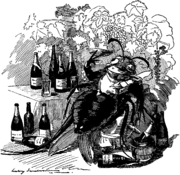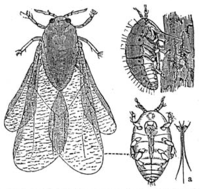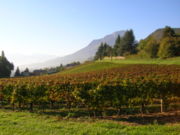
Great French Wine Blight
Encyclopedia

The Great French Wine Blight was a severe blight
Blight
Blight refers to a specific symptom affecting plants in response to infection by a pathogenic organism. It is simply a rapid and complete chlorosis, browning, then death of plant tissues such as leaves, branches, twigs, or floral organs. Accordingly, many diseases that primarily exhibit this...
of the mid-19th century that destroyed many of the vineyard
Vineyard
A vineyard is a plantation of grape-bearing vines, grown mainly for winemaking, but also raisins, table grapes and non-alcoholic grape juice...
s in France and laid to waste the wine industry. It was caused by an aphid
Aphid
Aphids, also known as plant lice and in Britain and the Commonwealth as greenflies, blackflies or whiteflies, are small sap sucking insects, and members of the superfamily Aphidoidea. Aphids are among the most destructive insect pests on cultivated plants in temperate regions...
(the actual genus of the aphid is still debated, although it is largely considered to have been a species of Daktulosphaira vitifoliae, commonly known as grape phylloxera) that originated in North America and was carried across the Atlantic in the late 1850s. While France is considered to have been worst affected, the blight also did a great deal of damage to vineyards in other European countries.
How the Phylloxera aphid was introduced to Europe remains debated: American vines had been taken to Europe many times before, for reasons including experimentation and trials in grafting, without consideration of the possibility of the introduction of pestilence. While the Phylloxera was thought to have arrived around 1858, it was first recorded in France in 1863, near the former province of Languedoc
Languedoc
Languedoc is a former province of France, now continued in the modern-day régions of Languedoc-Roussillon and Midi-Pyrénées in the south of France, and whose capital city was Toulouse, now in Midi-Pyrénées. It had an area of approximately 42,700 km² .-Geographical Extent:The traditional...
. It is argued by some that the introduction of such pests as phylloxera was only a problem after the invention of steamships, which allowed a faster journey across the ocean, and consequently allowed durable pests, such as the Phylloxera, to survive.
Eventually, following Jules-Emile Planchon's discovery of the Phylloxera as the cause of the blight, and Charles Valentine Riley
Charles Valentine Riley
Charles Valentine Riley was a British-born American entomologist and artist.-Early Life:The son of a Church of England minister, Charles Valentine Riley was born on 19 September, 1843 in London’s Chelsea district. When he was around eleven his parents, the Rev. Charles and Mary Riley, chose to...
's confirmation of Planchon's theory, Leo Laliman
Leo Laliman
Leo Laliman was a winegrower and viticulturist from Bordeaux, France. He, along with fellow winegrower Gaston Bazille, is largely accredited for the discovery that when European vines are grafted with suitable American rootstock, they become resistant to grape phylloxera...
and Gaston Bazille, two French wine growers, proposed that the European vines be grafted
Grafting
Grafting is a horticultural technique whereby tissues from one plant are inserted into those of another so that the two sets of vascular tissues may join together. This vascular joining is called inosculation...
to the resistant American rootstock that were not susceptible to the Phylloxera. While many of the French wine growers disliked this idea, many found themselves with no other option. The method proved to be an effective remedy. The following "Reconstitution" (as it was termed) of the many vineyards that had been lost was a slow process, but eventually the wine industry in France was able to return to relative normality.
Background

Vine
A vine in the narrowest sense is the grapevine , but more generally it can refer to any plant with a growth habit of trailing or scandent, that is to say climbing, stems or runners...
Vitis vinifera by French colonists in Florida, in the 16th century. These plantations were a failure, and later experiments with related species of vine also failed, although the reason for these failures appears to have been a mystery to the French colonists. It is known today that it was a species of North American grape phylloxera that caused these early vineyards to fail; the venom injected by the Phylloxera causes a disease that is quickly fatal to the European varieties of vine. The aphids went relatively unnoticed by the colonists, despite their great numbers, and the pressure and difficulty of successfully starting a vineyard in America at the time.
It became common knowledge among the settlers that their European vines, of the vinifera. variety, simply would not grow in American soil, and they resorted to growing native American plants, and established plantations of these native vines. Exceptions did exist; vinifera plantations were well-established in California before the aphids found their way there.
Phylloxera
There have been several theories proposed for why the phylloxera was ignored as the possible cause of the disease that resulted in the failure of so many vineyards, most of which involve the feeding behaviour of the insect, and the way it attacks the roots. The proboscisProboscis
A proboscis is an elongated appendage from the head of an animal, either a vertebrate or an invertebrate. In simpler terms, a proboscis is the straw-like mouth found in several varieties of species.-Etymology:...
of the grape phylloxera has both a venom canal from which it injects its deadly venom and a feeding tube through which it takes in vine sap
Sap
Sap may refer to:* Plant sap, the fluid transported in xylem cells or phloem sieve tube elements of a plant* Sap , a village in the Dunajská Streda District of Slovakia...
and nutrients. As the toxin
Toxin
A toxin is a poisonous substance produced within living cells or organisms; man-made substances created by artificial processes are thus excluded...
from the venom corrodes the root
Root
In vascular plants, the root is the organ of a plant that typically lies below the surface of the soil. This is not always the case, however, since a root can also be aerial or aerating . Furthermore, a stem normally occurring below ground is not exceptional either...
structure of a vine, the sap pressure falls and, as a result, the Phylloxera quickly withdraws its feeding tube and searches for another source of food. Thus, anyone digging up a diseased and dying vine will not find Phylloxera clinging to the roots of the plant.
Journey to Europe
For a few centuries, Europeans had experimented with American vines and plants in their soil, and many varieties were imported from America without regulation, disregarding the possibility of pest transfer, and related problems. Jules-Emile Planchon, a French biologistBiologist
A biologist is a scientist devoted to and producing results in biology through the study of life. Typically biologists study organisms and their relationship to their environment. Biologists involved in basic research attempt to discover underlying mechanisms that govern how organisms work...
, who identified the Phylloxera in the 1860s, maintained that this transfer of American vines and plants into Europe greatly increased between roughly 1858 and 1862, and this is how the Phylloxera was accidentally introduced to Europe around 1860, although the aphid did not enter France until around 1863. It is believed that the introduction of the blight-causing Phylloxera was not a problem before the advent of steamships, which were faster and hence allowed the Phylloxera to survive the quicker ocean voyage.
The blight

Initial appearance
The first known documented instance of an attack by the Phylloxera in France was in a department of the former province of LanguedocLanguedoc
Languedoc is a former province of France, now continued in the modern-day régions of Languedoc-Roussillon and Midi-Pyrénées in the south of France, and whose capital city was Toulouse, now in Midi-Pyrénées. It had an area of approximately 42,700 km² .-Geographical Extent:The traditional...
, some time around 1863. The wine makers there did not notice the aphids, just as the French colonists in America had not, but they noted the mysterious blight that was damaging their vines. The only description of the disease that was given by these wine growers was that it 'reminded them distressingly of "consumption"'. The blight quickly spread throughout France, but it was several years before the cause of the disease was determined.

Damage
Over 40% of French grape vines and vineyards were devastated over a 15-year period, from the late 1850s to the mid 1870s. The French economy was badly hit by the blight; many businesses were lost, and wages in the wine industry were cut to less than half. There was also a noticeable trend of migration to, among other places, AlgiersAlgiers
' is the capital and largest city of Algeria. According to the 1998 census, the population of the city proper was 1,519,570 and that of the urban agglomeration was 2,135,630. In 2009, the population was about 3,500,000...
and America. The production of cheap raisin
Raisin
Raisins are dried grapes. They are produced in many regions of the world. Raisins may be eaten raw or used in cooking, baking and brewing...
s and sugar wines caused problems for the domestic industry that threatened to persist even after the blight itself. The damage to the French economy, is estimated to have been slightly over 10 billion Francs.
Discovery
It was not until 1868 that the French biologist Jules-Emile Planchon and two colleagues, chanced upon a group of Phylloxera sucking from the roots of a plant that a theory on the blight's cause by the Phylloxera was formed, and it was not until 1870 that American entomologist Charles Valentine RileyCharles Valentine Riley
Charles Valentine Riley was a British-born American entomologist and artist.-Early Life:The son of a Church of England minister, Charles Valentine Riley was born on 19 September, 1843 in London’s Chelsea district. When he was around eleven his parents, the Rev. Charles and Mary Riley, chose to...
confirmed Planchon's theory. Riley was feted as a hero by the French, but the reaction to the discovery itself was mixed. Some met the news with optimism: now that the cause had been discovered, and the species identified, it would only be a matter of finding a method of eliminating the aphid. Others disagreed, saying that the insects were an effect of the blight, rather than the source. To complicate matters, the aphid's life-cycle proved difficult to study, as its lifespan differed from Europe to America.
Solution
Many growers resorted to their own methods in attempt to resolve the issue. Chemicals and pesticides were used to no avail. In desperation, some growers positioned toads under each vine, and others allowed their poultry to roam free in the hope they would eat the insects. None of these methods were successful.After Charles Valentine Riley confirmed Planchon's theory, Leo Laliman
Leo Laliman
Leo Laliman was a winegrower and viticulturist from Bordeaux, France. He, along with fellow winegrower Gaston Bazille, is largely accredited for the discovery that when European vines are grafted with suitable American rootstock, they become resistant to grape phylloxera...
and Gaston Bazille, two French wine growers, both suggested the possibility that if vinifera vines could be combined, by means of grafting
Grafting
Grafting is a horticultural technique whereby tissues from one plant are inserted into those of another so that the two sets of vascular tissues may join together. This vascular joining is called inosculation...
, with the aphid-resistant American vines, then the problem might be solved.
The method was tested, and proved a success. The process was colloquially termed "reconstitution" by French wine growers. The cure for the disease caused a great division in the wine industry: some, who became known as the "chemists", rejected the grafting solution and persisted with the use of pesticides and chemicals. Those who became grafters were known as "Americanists", or "wood merchants". Following the demonstrated success of grafting in the 1870s and 1880s the immense task of "reconstituting" the majority of France's vineyards began.
Prize
The French government had offered over 320,000 Francs as a reward to whoever could discover a cure for the blight. Having reportedly been the first to suggest the possibility of using the resistant American rootstock, Leo Laliman tried to claim the money, but the French government refused to award it, with the rationale that he had not cured the blight, but rather stopped it from occurring. However, there may have been other reasons for the government denying Laliman the prize: he was mistrusted by several notable parties, and he was thought by many to have originally introduced the pest. It should also be noted that the idea of grafting American rootstock into European vines and other plants was certainly not an original notion by Laliman; according to George Ordish, in his 1987 The Great Wine Blight, a Spanish Ordinance from 1524 had experimented with grafting their vines with Mexican rootstock, to achieve agricultural gain.
Present day
There is still no remedy, as such, for the Phylloxera, or the disease it brings with it, and it still poses a substantial threat to any vineyard not planted with grafted rootstock. In fact, there is only one European grape vine known to be resistant to the Phylloxera, the AssyrtikoAssyrtiko
Assyrtiko or Asyrtiko is a white Greek wine grape indigenous to the island of Santorini. Assyrtiko is widely planted in the arid volcanic-ash-rich soil of Santorini and other Aegean islands, such as Paros...
vine, which grows on the volcanic
Volcano
2. Bedrock3. Conduit 4. Base5. Sill6. Dike7. Layers of ash emitted by the volcano8. Flank| 9. Layers of lava emitted by the volcano10. Throat11. Parasitic cone12. Lava flow13. Vent14. Crater15...
Greek
Greece
Greece , officially the Hellenic Republic , and historically Hellas or the Republic of Greece in English, is a country in southeastern Europe....
island of Santorini
Santorini
Santorini , officially Thira , is an island located in the southern Aegean Sea, about southeast from Greece's mainland. It is the largest island of a small, circular archipelago which bears the same name and is the remnant of a volcanic caldera...
; however there is speculation that the actual source of this resistance may arise from the volcanic ash in which the vines grow, and not from the vine itself.
The events of the Great Wine Blight, and the need for European-American grafting has given rise to a debate that remains unresolved today: whether self-rooted vines produce better wine than those that are grafted.

